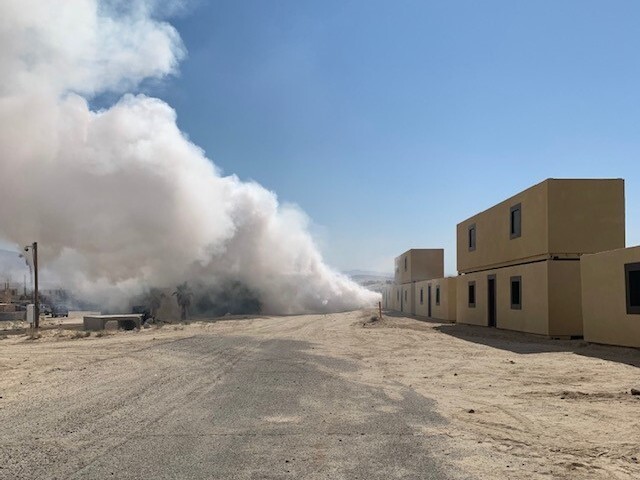
[ad_1]
The Army is now getting back to large-scale training, after several months preparing to hold off that invisible foe: the coronavirus.
Back in May at its massive training base in the Mojave Desert, the Army practiced taking temperatures, isolating soldiers who tested positive and socially distancing.
It was all in preparation for 4,000 National Guard soldiers from 20 states who arrived recently at Fort Irwin, Calif., for two weeks of training at this vast swath of deserts and mountains the size of Rhode Island.

National Guard soldiers take part in desert training at Fort Irwin, Calif.
Tom Bowman
hide caption
toggle caption
Tom Bowman
The soldiers, who started arriving in the last several weeks are the first to return to large-scale training here since March, when the pandemic hit. The Army cancelled two other units during the spring until it could come up with safety measures.
On this recent training day, the soldiers attack the mock village of Seize Razish. Machine gun fire, artillery barrages echo off the barren hills. Armored vehicles speed across the open desert, kicking up plumes of dust.

Smoke billows up at the mock village of Seize Razish.
Tom Bowman
hide caption
toggle caption
Tom Bowman

Smoke billows up at the mock village of Seize Razish.
Tom Bowman
Brigadier Gen. Dave Lesperance commands this National Training Center, and watches from a hilltop.
“Today you have two battalions in the attack right now,” he says.
The village is a cluster of squat, concrete buildings, some several stories high. They’re brown, and beige and rust colored. From this hilltop perch, they resemble a child’s building blocks.
Gen. Lesperance points to mountain passes in the distance, more like scars in the parched earth.
“So, we called that one granite pass,” he says. “There’s another one called the wormhole, and then there’s a passage to India. These are all Hollywood names.”
This desert training is not new. The Army’s been rotating thousands of soldiers here every few months for nearly four decades to fight the resident opposition force. Think of it as a sophisticated laser tag. What’s new, the general says, is a key piece of equipment.
“I was pleasantly surprised with the level of discipline and approach to wearing this mask out here,” he says.
And the general himself is wearing a mask as he explains all this. So too is the Army’s top officer, Gen. Jim McConville who stands nearby watching the mock attack. McConville sports a camouflage one that matches his uniform.
“If you look we have our helmets on. We’ve got our glasses on. We’ve got a mask on,” McConville says. “And if you look around, it’s kind of the standard.”
What if a soldier is not wearing a mask or let’s is slip off his face? Lesperance has a ready answer.
“Hey, get your mask on!”
That same message, he says, is expected from the observers — sort of coaches who follow the action here — as well as the junior officers.

Gen. Jim McConville observes training at Fort Irwin.
Curt Kellogg.
hide caption
toggle caption
Curt Kellogg.
Gen. McConville says the mask, as well as widespread testing is all part of getting the Army safely back to large-scale training. A few months ago, the Army had to scale down a large exercise in Europe because of the pandemic.
“You know, you can’t telecommute to combat,” he says. “So, we have to go and we have to put soldiers on the ground. We have to do it around the world. And they got to be highly trained just and fit. So, we have to train them, you know? And so, we’ve got to do this.”
The Guard soldiers were tested before coming here, says Lesperance, and screened once again when they came to Fort Irwin.
“And so, we did identify positive soldiers. It was there was less than 20 that,” he said. “And our systems worked.”
Those soldiers were isolated, the general said, but not one was hospitalized. Contact tracing led to another one hundred soldiers who had to be quarantined.
“You don’t want that 1% to grow to 10%,” McConville said. “You want to be able to isolate it. You want to be able to screen it. And then you’ve got to do continuous surveillance because you don’t want someone to spread it throughout the force”
Since those soldiers were so spread out among the 4,000, it’s had no effect on the two-week training effort, that includes the assault on the village. Soldiers are constantly monitored for symptoms, the generals say. Temperatures are taken daily.
The generals hop into Humvees for the drive through the mock village of Seize Razish. Soldiers crouch against walls, while others stand guard. Most wear masks. We pass abandoned cars, a portrait of Afghan president Hamid Karzai on a plaster wall, a building with a minaret that resembles a mosque. Then we pass a handful of soldiers, huddled in front or an armored vehicle.
Not one is wearing a mask.
Just ahead is the commander of this unit, Col. Timothy Kemp of the Minnesota National Guard, who is wearing a face mask.
“Well, it’s something that’s a new part of our uniform,” he said.
When told some of his soldiers were not wearing masks, the colonel said: “And that’s something that we have to talk with the soldiers about and help them understand that the reason for doing that and to protect each other by wearing a mask.”
[ad_2]
Source link